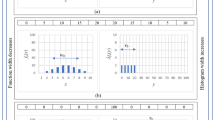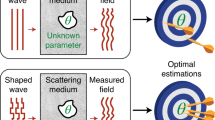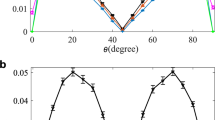Abstract
The statistical description of optical fields in classical coherence theory is the foundation for many applications in metrology, microscopy, lithography and astronomy. Partial coherence is commonly attributed to underlying fluctuations originating at the source or arising upon passage through a random medium. A less acknowledged source of uncertainty (partial coherence) stems from the act of ignoring a degree of freedom of a beam when observing another degree of freedom coupled to (or classically entangled with) it. We demonstrate here that Bell's measure, which is commonly used in tests of quantum non-locality, may be used as a quantitative tool in classical optical coherence to delineate native incoherence associated with statistical fluctuations from correlation- (or, entanglement-) based incoherence. Our results demonstrate the applicability of the concepts recently developed in quantum information science to classical optical coherence theory and optical signal processing.
This is a preview of subscription content, access via your institution
Access options
Subscribe to this journal
Receive 12 print issues and online access
$209.00 per year
only $17.42 per issue
Buy this article
- Purchase on Springer Link
- Instant access to full article PDF
Prices may be subject to local taxes which are calculated during checkout





Similar content being viewed by others
References
Kipnis, N. History of the Principle of Interference of Light (Birkhäuser Verlag, 1991).
Born, M. & Wolf, E. Principles of Optics (Cambridge Univ. Press, 1999).
Mandel, L. & Wolf, E. Optical Coherence and Quantum Optics (Cambridge Univ. Press, 1995).
Wolf, E. Introduction to the Theory of Coherence and Polarization of Light (Cambridge Univ. Press, 2007).
Goodman, J. W. Speckle Phenomena in Optics (Roberts & Company, 2007).
Wolf, E. Unified theory of coherence and polarization of random electromagnetic beams. Phys. Lett. A 312, 263–267 (2003).
Horne, M. A., Shimony, A. & Zeilinger A. Two-particle interferometry. Phys. Rev. Lett. 62, 2209–2212 (1989).
Jaeger, G., Horne, M. A. & Shimony, A. Complementarity of one-particle and two-particle interference. Phys. Rev. A 48, 1023–1027 (1993).
Abouraddy, A. F., Nasr, M. B., Saleh, B. E. A., Sergienko, A. V. & Teich, M. C. Demonstration of the complementarity of one- and two-photon interference. Phys. Rev. A 63, 063803 (2001).
Nielsen, M. A. & Chuang, I. L. Quantum Computation and Quantum Information (Cambridge Univ. Press, 2000).
Bouwmeester, D., Ekert, A. K. & Zeilinger, A. (eds) The Physics of Quantum Information (Springer, 2000).
Einstein, A., Podolsky, B. & Rosen, N. Can quantum-mechanical description of physical reality be considered complete? Phys. Rev. 47, 777–780 (1935).
Schrödinger, E. Discussion of probability relations between separated systems. Proc. Camb. Phil. Soc. 31, 555–563 (1935).
Bohm, D. Quantum Theory (Prentice-Hall, 1951).
Bell, J. S. On the Einstein–Podolsky–Rosen paradox. Physics (Long Island City) 1, 195–200 (1964).
Aiello, A. & Woerdman, J. P. Intrinsic entanglement degradation by multimode detection. Phys. Rev. A 70, 023808 (2004).
Aiello, A. & Woerdman, J. P. Physical bounds to the entropy-depolarization relation in random light scattering. Phys. Rev. Lett. 94, 090406 (2005).
Aiello, A., Puentes, G. & Woerdman, J. P. Linear optics and quantum maps. Phys. Rev. A 76, 032323 (2007).
Yarnall, T., Abouraddy, A. F., Saleh, B. E. A. & Teich, M. C. Spatial coherence effects in second- and fourth-order temporal interference. Opt. Express 16, 7634–7640 (2008).
Simon, B. N. et al. Nonquantum entanglement resolves a basic issue in polarization optics. Phys. Rev. Lett. 104, 023901 (2010).
Qian, X-F. & Eberly, J. H. Entanglement and classical polarization states. Opt. Lett. 36, 4110–4112 (2011).
Borges, C. V. S., Hor-Meyll, M., Huguenin, J. A. O. & Khoury, A. Z. Bell-like inequality for the spin–orbit separability of a laser beam. Phys. Rev. A 82, 033833 (2010).
Holleczek, A., Aiello, A., Gabriel, C., Marquardt, C. & Leuchs, G. Classical and quantum properties of cylindrically polarized states of light. Opt. Express 19, 9714–9736 (2011).
Wootters, W. K. Quantum entanglement as a quantifiable resource. Phil. Trans. R. Soc. Lond. A 356, 1717–1731 (1998).
Abouraddy, A. F., Yarnall, T., Saleh, B. E. A. & Teich, M. C. Violation of Bell's inequality with continuous spatial variables. Phys. Rev. A 75, 052114 (2007).
Yarnall, T., Abouraddy, A. F., Saleh, B. E. A. & Teich, M. C. Experimental violation of Bell's inequality in spatial-parity space. Phys. Rev. Lett. 99, 170408 (2007).
Yarnall, T., Abouraddy, A. F., Saleh, B. E. A. & Teich, M. C. Synthesis and analysis of entangled photonic qubits in spatial-parity space. Phys. Rev. Lett. 99, 250502 (2007).
Saleh, B. E. A. & Teich, M. C. Fundamentals of Photonics 2nd edn (Wiley-Interscience, 2007).
Gori, F., Santarsiero, M. & Borghi, R. Vector mode analysis of a Young interferometer. Opt. Lett. 31, 858–860 (2006).
Hill, S. & Wootters, W. K. Entanglement of a pair of quantum bits. Phys. Rev. Lett. 78, 5022–5025 (1997).
Abouraddy, A. F., Saleh, B. E. A., Sergienko, A. V. & Teich, M. C. Degree of entanglement for two qubits. Phys. Rev. A 64, 050101(R) (2001).
Brosseau, C. & Dogariu, A. in Progress in Optics (ed. Wolf, E.) Vol. 49, Ch. 4 (Elsevier, 2006).
Abouraddy, A. F., Di Giuseppe, G., Yarnall, T. M., Teich, M. C. & Saleh, B. E. A. Implementing one-photon three-qubit quantum gates using spatial light modulators. Phys. Rev. A 86, 050303 (2012).
Clauser, J. F., Horne, M. A., Shimony, A. & Holt, R. A. Proposed experiment to test local hidden-variable theories. Phys. Rev. Lett. 23, 880–884 (1969).
Aspect, A., Grangier, P. & Roger, G. Experimental tests of realistic local theories via Bell's theorem. Phys. Rev. Lett. 47, 460–463 (1981).
Aspect, A., Grangier, P. & Roger, G. Experimental realization of Einstein–Podolsky–Rosen–Bohm Gedankenexperiment: a new violation of Bell's inequalities. Phys. Rev. Lett. 49, 91–94 (1982).
Cirel'son, B. S. Quantum generalizations of Bell's inequality. Lett. Math. Phys. 4, 93–106 (1980).
Collins, D., Gisin, N., Linden, N., Massar, S. & Popescu, S. Bell inequalities for arbitrarily high dimensional systems. Phys. Rev. Lett. 88, 040404 (2002).
Dada, A. C., Leach, J., Buller, G. S., Padgett, M. J. & Andersson, E. Experimental high-dimensional two-photon entanglement and violations of generalized Bell inequalities. Nature Phys. 7, 677–680 (2011).
Gabor, D. in Progress in Optics (ed. Wolf, E.) Vol. 1, Ch. 4 (Elsevier, 1961).
Miller, D. A. B. Communicating with waves between volumes: evaluating orthogonal spatial channels and limits on coupling strengths. Appl. Opt. 39, 1681–1699 (2000).
Ekert, A. & Knight, P. L. Entangled quantum systems and the Schmidt decomposition. Am. J. Phys. 63, 415–423 (1995).
Życzkowski, K., Penson, K. A., Nechita, I. & Collins, C. Generating random density matrices. J. Math. Phys. 52, 062201 (2011).
Acknowledgements
The authors thank A. Dogariu and J.W. Goodman for useful discussions, and A. Dogariu and W.V. Schoenfeld for the loan of equipment.
Author information
Authors and Affiliations
Contributions
A.F.A. and B.E.A.S. conceived the idea and directed the project. K.H.K. and G.D.G. carried out the experiments and the theoretical calculations. All authors contributed to analysing the results and writing the manuscript.
Corresponding authors
Ethics declarations
Competing interests
The authors declare no competing financial interests.
Supplementary information
Supplementary information
Supplementary information (PDF 461 kb)
Rights and permissions
About this article
Cite this article
Kagalwala, K., Di Giuseppe, G., Abouraddy, A. et al. Bell's measure in classical optical coherence. Nature Photon 7, 72–78 (2013). https://doi.org/10.1038/nphoton.2012.312
Received:
Accepted:
Published:
Issue Date:
DOI: https://doi.org/10.1038/nphoton.2012.312
This article is cited by
-
Revealing the invariance of vectorial structured light in complex media
Nature Photonics (2022)
-
Spin–orbit microlaser emitting in a four-dimensional Hilbert space
Nature (2022)
-
Correlation-induced coherence and its use in detecting quantum phase transitions
Science China Physics, Mechanics & Astronomy (2022)
-
Universal quantum gates for path photonic qubit
Quantum Information Processing (2022)
-
Entanglement goes classically high-dimensional
Light: Science & Applications (2021)



